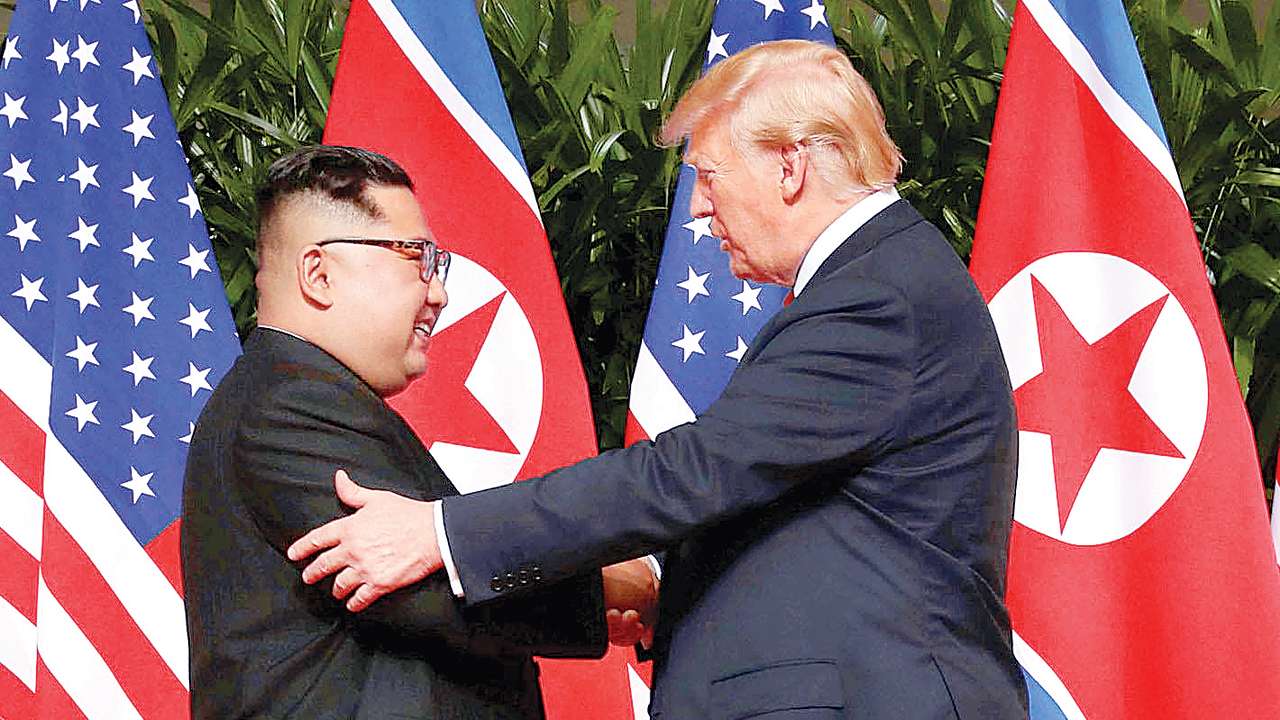
That two nations, as viscerally antagonistic as North Korea and the US, would agree to hold a summit of peace needs courage. Haunted by a history of paranoia, perfidy, and victimhood, such peace-making may appear reckless too. Kim Jong-un and Donald Trump inked a joint declaration in which Kim made a commitment to total denuclearisation of the Korean peninsula. “Anyone can make war but only the most courageous can make peace,” Trump told the goggle-eyed media at the Capella Hotel on Sentosa island in Singapore. “People thought this could never take place but it is taking place.”
As to the question of overtures made to the call for peace, Kim overturned the consensus that negotiations were unlikely to work ever after the Kim Jong-il regime defied the United Nations by launching a ballistic missile and conducting its second underground nuclear test in 2009. Ever since Kim Jong-il proclaimed his “military-first” government, effectively shaking off responsibility for the country’s economic ruin and invoking kamikaze slogans, anti-Americanism became the living mantra to sustain the dictatorial rule in Pyongyang. It lent credence to only one conclusion that the regime is worried that the masses might cease to perceive the US as an enemy, thus leaving it with no way to justify its rule – or even to justify the existence of the DPRK as a separate state. Lest we forget, North Korea is one of two states laying claim to the same nation, which had either to convince its citizens that it is the better Korea or involuntarily accept Seoul’s right to rule the whole peninsula.
In terms of realpolitik as well, Kim Jong-un was prudent enough to seek a negotiated settlement of peace with US, for the larger security of the Korean peninsula, mindful of the situation in the 1970s and 1980s, when the North Korean government maintained its balanced diplomatic position between the country’s only two significant allies, China and the Soviet Union, while sustaining a hostile attitude towards the US. But with the dissolution of the USSR in the early 1990s, it had only China as its sole major ally, which it began to distrust after the latter cultivated friendly relations with South Korea. With South Korea as American protégé, the best course of action left to a desperate Kim was certainly to hold truce with the US to lift the sanctions.
Since the denuclearisation of the Korean Peninsula is the pivot of the Trump-Kim rapprochement, it bears recalling that in 1991, the North and South Koreas were simultaneously admitted to the United Nations, and a series of prime-ministerial talks produced two agreements between them. One agreement pledged non-aggression, reconciliation, exchanges, and cooperation. The other was a joint declaration on the denuclearisation of the Korean peninsula. The agreements went into effect in February 1992, although little of substance came of them, especially after the North became embroiled in controversy over its nuclear programme and suspended all contacts with the South in early 1993. In 1994, the DPRK – Democratic People’s Republic of Korea – had signed an agreement with the US called the Agreed Framework where the latter was dilatory in keeping its promises, partly because Clinton had lost control of Congress to the Republicans.
Denuclearisation being the longstanding policy of the Pyongyang regime, it is a no-brainer that Kim’s ‘concession’ in the joint statement is anything novel. The devil lies in the detail as it interprets this as being an open-ended, gradual process in which other nuclear powers will also disarm. It is to be noted that the definition, tom-tommed so far by the Trump administration, of “complete, verifiable, irreversible dismantlement”, was missing from the joint statement. For North Korea, complete denuclearisation is inseparable from the withdrawal of US troops from neighbouring South Korea and Japan, which will never be easy for the US to digest, without raising the hackles of Tokyo, and of Seoul, smarting under the prospect of a withdrawal of US troops from that country. A summit between the two Koreas in 2007, and also a six-nation summit in 2008 failed to make much headway for the inherent contradictions. But the past failings notwithstanding, China, South Korea, Japan, and Russia must be taken on board.
To move towards a goal of total denuclearisation that might mark the US-North Korea summit on June 12, 2018, as truly ‘historic’, what is first necessary is to build a relationship of trust based on complete transparency with no room for prevarication. Browbeating or one-upmanship, knee-jerk reaction or intemperance might undo the entire initiative. There is no report if President Trump enjoyed the main course – beef short rib confit with potato dauphinoise and steamed broccolini, a combination of sweet and sour crispy pork and Yangzhou fried rice, and ‘daegu jorim’ – soy braised codfish with radish and Asian vegetables, over the dessert – dark chocolate tartlet ganache, tarte tropezienne and Häagen-Dazs’ vanilla ice cream with cherry coulis – in his working lunch with Kim. But as the leader hailing from one of the perceived aggressor nations since the Korean War in 1953, the ball is more in the court of Trump to set sight on the main course of action laid with minefields. The DPRK must not be another Libya.
The author is a teacher and commentator on geopolitical affairs